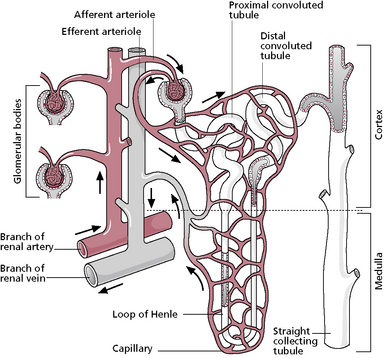Chapter 2 The Female Urinary Tract
The kidneys
The kidneys are two bean-shaped glands that have both endocrine and exocrine secretions.
Functions
Functions of the kidneys are shown in Box 2.1.
Box 2.1 Functions of the kidneys
• Elimination of waste, particularly the breakdown products of protein, such as urea, urates, uric acid, creatinine, ammonia and sulphates
• Regulation of the water content of the blood and indirectly of the tissues
• Regulation of the pH of the blood
• Regulation of the osmotic pressure of the blood
Inner structure
• The glandular tissue is formed of cortex on the outside and medulla within. The cortex is dark with a rich blood supply, whereas the medulla is paler.
• A collecting area for urine merges with the upper ureter and is called the pelvis. It is divided into branches or calyces.
• Each calyx forms a cup over a projection of the medulla known as a pyramid. There are some 12 pyramids in all and they contain bundles of tubules leading from the cortex.
• The tubules create a lined appearance and these are the medullary rays.
• The base of each pyramid is curved and the cortex arches over it and projects downwards between the pyramids, forming columns of tissue (columns of Bertini).
The nephrons (Fig. 2.1)
The tissue of the kidney is made up of about 1 million nephrons, which are its functional units.
• Each nephron starts at a knot of capillaries called a glomerulus.
• It is fed by a branch of the renal artery, the afferent arteriole. (Afferent means ‘carrying towards’.)
• The blood is collected up again into the efferent arteriole. (Efferent means ‘carrying away’.)
• Surrounding the glomerulus is a cup known as the glomerular capsule, into which fluid and solutes are exuded from the blood.
• The glomerulus and capsule together comprise the glomerular body. The pressure within the glomerulus is raised because the afferent arteriole is of a wider bore than the efferent arteriole; this factor forces the filtrate out of the capillaries and into the capsule. At this stage there is no selection; any substance with a small molecular size will filter out.
• The cup of the capsule is attached to a tubule, as a wine glass is to its stem. The tubule initially winds and twists, then forms a straight loop which dips into the medulla, rising up into the cortex again to wind and turn before joining a straight collecting tubule, which receives urine from several nephrons.
• The first twisting portion of the nephron is the proximal convoluted tubule, the loop is termed the loop of Henle and the second twisting portion is the distal convoluted tubule.
< div class='tao-gold-member'>
Stay updated, free articles. Join our Telegram channel

Full access? Get Clinical Tree



